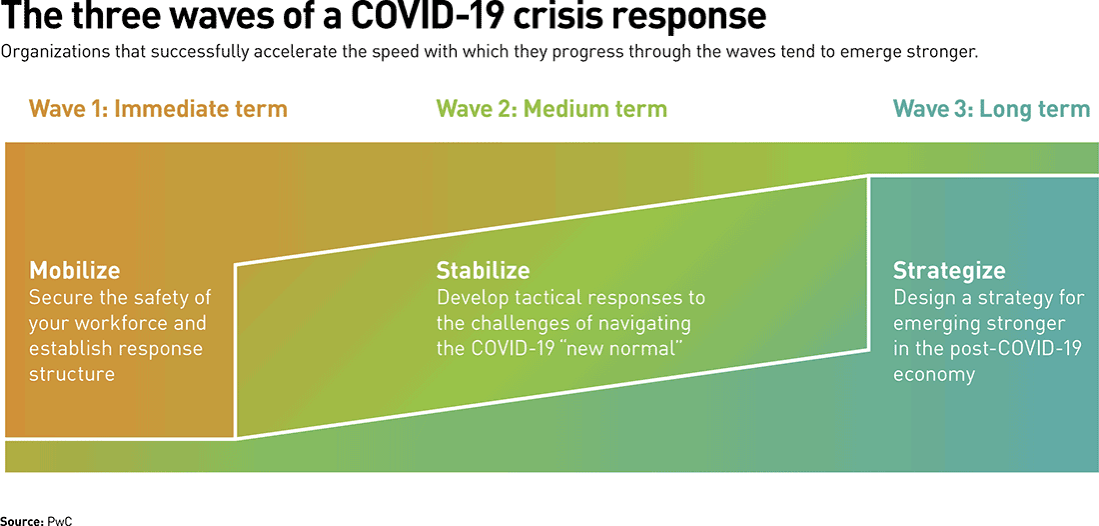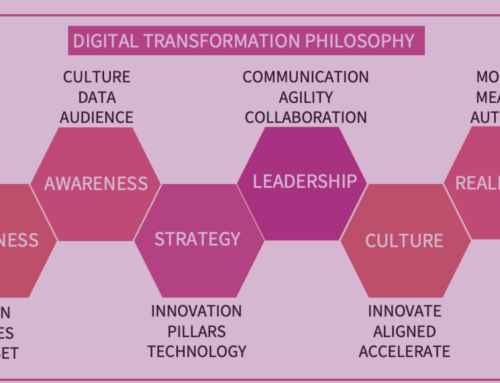So here we are, in the new normal we’ve heard so much about over the last few months? Since much of the world went into some kind of lockdown earlier this year, everyone has been talking about how much is going to have to change, and how we won’t be returning to how things were for a long time, if ever.
Over the last few months, the business world, like the rest of the world, has undergone many changes. Some positive, with good news stories about businesses which have turned on a dime to offer new products or services, or to deliver them in different ways, and have come out on top.
But we’ve also heard about those who couldn’t make it – high street retailers who will never reopen, and big names who aren’t going to survive without massive bailouts.
Whilst it’s great that so many businesses are being able to open their doors again in a very real sense, it would be a mistake to think that where we are now is the ‘new normal’.
PwC’s analysis of the 3 waves of a Covd-19 crisis response shows this neatly. Businesses are at different stages, but, on the whole, we’re only just at the point of moving into Wave 2 right now, with many organisations still trying to manage their Wave 1 immediate term responses:

So, far from where we are right now being the new normal, I believe we now in a holding pattern which will last for at least the next 12-18 months – or until some of the thought leaders in the world’s most commercially viable organisations spearhead a movement to learn from the past, in order to build better future based on a clear vision.
What we’re looking for now is a path to the new normal.
What does this really mean for business?
One thing that is clear is that the digital world will be at the centre of everything. Over the last few months we’ve all relied on digital technology like never before.
Before lockdown, my job was to go into and work with corporates in MENA, and that meant I spent my life jumping on ‘Planes, Trains, and Automobiles’ (shout out to the amazing Steve Martin, and the late, great John Candy), spending days travelling around different time zones, with lots of downtime, and working while managing jet lag.
I’ve always been digital first, but with a big slice of my business reliant on my physical presence, you’d imagine that the sudden grounding of international travel would have been a disaster for me. And it was certainly painful.
But the truth is that since lockdown began I’ve been able to reach even more people with the same message, through re-engineering how I operate.
Essentially, we all need to find ways to focus our customers’ attention on us and drive real engagement, and that means thinking digital first.
Why digital transformation is the key
In this new digital-first world, simply digitising our traditional business processes and using tools designed to connect us will not be enough.
Digital transformation is all about using technologies to do things in a different and better way.
This is an opportunity for the whole business to not just modernise how it works, but its entire functional structure – from front to back office, focussed on how it resonates with its customers’ needs and the employee culture.
So this is really about innovation; listening to our customers’ needs and then letting the IT drive the change needed for the business to thrive in the new normal.
We’ve got to prioritise that, and digital transformation at the centre of changing the way we operate, and making us more relevant in a changing economy.
Now is the time for leadership to get bold. Whilst as a society, we’re generally emerging from lockdown fairly cautiously, the businesses who succeed will be those who take a proactive approach to finding the (right) ways to use digital technology to learn more about their customers, truly interact with them and meet their needs in new and innovative ways.
There are plenty of examples of businesses who have used digital technology to thrive during this first wave of the response to the Covid-19 crisis. From small, local restaurants who switched overnight to offering online ordering and contactless delivery (whilst also, crucially, offering the opportunity for communities to support the vulnerable by contributing towards meals for, for example, the elderly and isolated), to retailers who swiftly improved their e-commerce presence, or personal fitness leaders who now offer a wealth of online training resources and support.
But for long-term success, these options need to be part of a total strategy of digital interaction. We are not going to return to selling in the old ways.
We can’t rely on our customers passively watching, reading or listening to our content. We need to put them in control of how they experience our brand, and enable them to truly engage with us if we are to stay front of mind for long enough for them to buy from us.
Leading a workforce into the new normal
If you’ve been among the business leaders who had to switch rapidly to home working, now is the time to make sure your remote working policies ensure that people are able to work from home safely and efficiently. With home working come cyber-security risks for your organisation, and potential issues of isolation for your workforce, for example.
Your staff, whether still working or on furlough, may be concerned for their job security, so regular communication with them about the steps you’re taking is also vital.
When you’re planning what shape your digital transformation is going to take, you’ll need to define what critical activities can still operate, and who has the skills to support them. This will highlight potential skills gaps, and now would be a good time to look at upskilling so that your teams can support new and existing critical operations.
This is an opportunity to completely redefine your infrastructure to build a business that is designed to meet customer needs in a rapidly changing world.
Building a brand for the new normal
How much do you really know about how your customers view you? And how much do you really understand about their behaviours and expectations? What do they see as the ideal customer experience, and how well do you match up to that?
Now is the time to embrace the power of data to give you those insights into what your customers are doing, and where there are gaps in your response to their needs that you need to fill.
We could talk about the individual technologies here – AI, chatbots, mobile data etc – but the point is not to see any of them in isolation, but to look at what your customer needs are, and then invest in the technologies that are going to enable you to fulfil them.
A digital strategy is no longer a ‘nice to have’, and a study by Bain and Deloitte has identified the most important element of sales and marketing in the digital world as customer engagement. That means providing relevant information, multisensory interaction, and making an emotional connection through the power of your brand.
In many ways, what I’m saying to you about leadership for thinking digital first hasn’t changed. But the crucial point here is that the timeframe has changed. What was, until recently, important for your long-term success, could now, in the Covid-19 world (and let’s not pretend it’s a post-Covid world just yet, it may never be) become a case of survival beyond the next few months.
But if you’re willing to learn, adapt and lead digital transformation across your organisation this crisis could also present a huge opportunity.
Ready to produce game-changing digital results in your business?
Subscribe to receive cutting edge insights on digital leadership and transformation- straight to your inbox
We do not sell or share your information with anyone.









